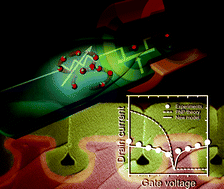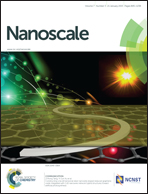Sub-10 nm transparent all-around-gated ambipolar ionic field effect transistor†
Abstract
In this paper, we developed a versatile ionic field effect transistor (IFET) which has an ambipolar function for manipulating molecules regardless of their polarity and can be operated at a wide range of electrolytic concentrations (10−5 M–1 M). The IFET has circular nanochannels radially covered by gate electrodes, called “all-around-gate”, with an aluminum oxide (Al2O3) oxide layer of a near-zero surface charge. Experimental and numerical validations were conducted for characterizing the IFET. We found that the versatility originated from the zero-charge density of the oxide layer and all-around-gate structure which increased the efficiency of the gate effect 5 times higher than a previously developed planar-gate by capacitance calculations. Our numerical model adapted Poisson–Nernst–Planck–Stokes (PNPS) formulations with additional nonlinear constraints of a fringing field effect and a counter-ion condensation and the experimental and numerical results were well matched. The device can control the transportation of ions at concentrations up to 1 M electrolyte which resembles a backflow of a shale gas extraction process. Furthermore, while traditional IFETs can manipulate either positively or negatively charged species depending on the inherently large surface charge of oxide layer, the presenting device and mechanism provide effective means to control the motion of both negatively and positively charged molecules which is important in biomolecule transport through nanochannels, medical diagnosis system and point-of-care system, etc.


 Please wait while we load your content...
Please wait while we load your content...